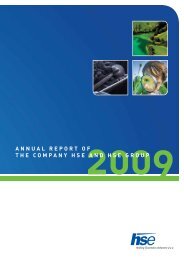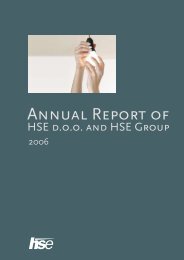Annual report - HSE
Annual report - HSE
Annual report - HSE
Create successful ePaper yourself
Turn your PDF publications into a flip-book with our unique Google optimized e-Paper software.
4.5.8.8 Financial instruments and risks<br />
This section refers to Section 4.5.7.19 of the financial <strong>report</strong> as well as to the chapter about<br />
financial risks in the business <strong>report</strong>.<br />
4.5.8.8.1 Credit risk<br />
An important part of activities where we face the risk of partners’ non-fulfilment of<br />
obligations results from trading and financial activity where the majority of these activities<br />
are represented by contractual relations with partners with high credit rating. We decide<br />
upon the form of business relationship with other partners on the basis of prior analysis<br />
of partner’s credit rating, which further defines the possible volume and time horizon of<br />
operations, elements of contractual relationship and particularly the necessary volume<br />
of additional collaterals for complying with contractual liabilities in form of bank and<br />
corporate guarantees, advances received and other adequate forms of insurance. In<br />
forming contractual relationship and selecting insurance we particularly consider possible<br />
limitations of partner’s local legislation, since it is fundamental in the procedure of<br />
collection of potentially unfulfilled obligations or realisation of insurance received.<br />
Credit exposure to individual partners is monitored on a daily basis; accordingly, credit<br />
risks are monitored and managed through adaptation of operational limits and timely<br />
demands to potentially submit additional insurances. If assessed that the partners’ credit<br />
ratings have deteriorated or that increased credit exposure was a result of increase in<br />
general (expected) level of market prices, we immediately request additional insurances.<br />
Unsecured part of receivables is the sum of portion of sales to partners on open account<br />
within the framework of defined loan limits. Sale on open account is in accordance with<br />
internal regulations and possible within the framework of approved loan limits to partners<br />
with regard to their financial capacity and risk. The most frequent among unsecured<br />
receivables are the receivables from partners with the highest credit rating and from<br />
partners which belong to a highly regulated activity and are frequently state-owned. The<br />
latter also include providers of system services, where insurance for receivables cannot<br />
be obtained, as in case of stock exchanges, but belong to credit rating category with a low<br />
non-fulfilment risk nevertheless.<br />
Regardless of estimated low partnership risk, each credit rating class represents higher<br />
or lower average risk of loss due to non-payment or non-fulfilment of contractual<br />
obligations. Even the secured receivables carry a certain risk of non-fulfilment with<br />
regard to the guarantor’s credit rating. Both are monitored through assessing the value<br />
of potential loss due to non-fulfilment. Receivables due from partners are secured with<br />
bank and corporate guarantees, pledge of receivables from contracts on management<br />
of transaction accounts, and deposits. Receivables are exclusively secured with bills<br />
of exchange, namely in combination with corporate guarantees, or as an independent<br />
instrument in case of smaller volume of transactions with a partner. If in the latter case the<br />
partner is a limited liability company owned by physical persons, receivables are secured<br />
with bills of exchange. The company has secured app. 85% of its receivables from buyers.<br />
In 2012, our partners have regularly complied with their obligations, with rare exceptions.<br />
In case of delays, the customers in Slovenia and abroad are charged default interest<br />
under contractual rate. The majority of overdue receivables at the end of 2012 refer to<br />
invoices issued for electricity sold that have already been settled by the time this <strong>report</strong><br />
was prepared.<br />
At the end of 2012, the company has EUR 854,273 of doubtful receivables.<br />
In 2012, a new doubtful receivable from electricity sales was created and amounts to 75%<br />
of the initial receivable. The value of doubtful receivables was assessed considering the<br />
average amount of repayments in receivership proceedings.<br />
<strong>Annual</strong> Report <strong>HSE</strong> 2012<br />
4 Financial Report of the company <strong>HSE</strong><br />
151
















